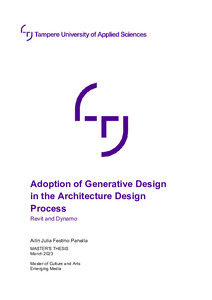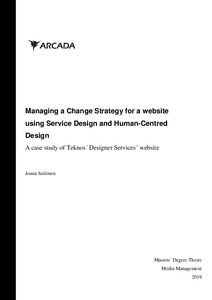Adoption of generative design in the architecture design process : Revit and Dynamo
Festino Panella, Ailin Julia (2023)
Festino Panella, Ailin Julia
2023
All rights reserved. This publication is copyrighted. You may download, display and print it for Your own personal use. Commercial use is prohibited.
Julkaisun pysyvä osoite on
https://urn.fi/URN:NBN:fi:amk-202303294404
https://urn.fi/URN:NBN:fi:amk-202303294404
Tiivistelmä
The architecture design process is a complex matter that involves many actors, and problems can emerge unexpectedly. Finding the most convenient and fast solutions is essential to diminish the risks during the rest of the project and to ensure long-term sustainability. The commissioner of this thesis is Raami Architects, a Tampere-based architecture firm with more than 20 years of workingexperience. Hospitals, daycare, urban planning, and residential and office buildings are among their projects. The company wished to venture into Generative Design (GD), having as tools Revit and Dynamo.
The thesis aims to determine the benefits and challenges of adopting GD as an aiding tool to complement the current traditional design process. The objectives followed to achieve the goals are: To contemplate the benefits and challenges of using GD, to recognize the most common problems that emerge during the architectural design process, to analyze the impact of GD on the current design process of Raami, to identify the type of projects and tasks that benefit from GD, to determine the resources necessary for the adoption of GD, and to study and experiment with Revit and Dynamo GD tools.
The theoretical background of the thesis consists of literature on the architectural design process and GD for the Architecture, Engineering, and Construction (AEC) industry. Qualitative surveys, one-on-one interviews, and the learning experience of the author were used as material for the research.
Based on the research, it was concluded that the adoption of GD as a tool in the design process at Raami may be beneficial. It was also concluded that GD shouldbe used mainly in the early stage of complex projects and to solve problems that can be formulated mathematically. Identifying the type of problems GD can solve and knowing the possibilities, limitations, and when to use GD tools is essential to control the expectations of the designer. The research limitations were time-based. It would have been positive to analyze the experiences of other companies that have already adopted GD. It would have also been interesting to experiment with real architecture projects, but it was impossible due to the thesis schedule and the limitations on handling the tools.
The thesis aims to determine the benefits and challenges of adopting GD as an aiding tool to complement the current traditional design process. The objectives followed to achieve the goals are: To contemplate the benefits and challenges of using GD, to recognize the most common problems that emerge during the architectural design process, to analyze the impact of GD on the current design process of Raami, to identify the type of projects and tasks that benefit from GD, to determine the resources necessary for the adoption of GD, and to study and experiment with Revit and Dynamo GD tools.
The theoretical background of the thesis consists of literature on the architectural design process and GD for the Architecture, Engineering, and Construction (AEC) industry. Qualitative surveys, one-on-one interviews, and the learning experience of the author were used as material for the research.
Based on the research, it was concluded that the adoption of GD as a tool in the design process at Raami may be beneficial. It was also concluded that GD shouldbe used mainly in the early stage of complex projects and to solve problems that can be formulated mathematically. Identifying the type of problems GD can solve and knowing the possibilities, limitations, and when to use GD tools is essential to control the expectations of the designer. The research limitations were time-based. It would have been positive to analyze the experiences of other companies that have already adopted GD. It would have also been interesting to experiment with real architecture projects, but it was impossible due to the thesis schedule and the limitations on handling the tools.
Kokoelmat
Samankaltainen aineisto
Näytetään aineisto, joilla on samankaltaisia nimekkeitä, tekijöitä tai asiasanoja.
-
Managing a Change Strategy for a website using Service Design and Human-Centred Design : A case study of Teknos´ Designer Services´ website
Seilonen, Jonna (2019)This study is based on the website service development. It analyses how a change strategy may be managed for a website based on user preferences and recommendations. The aim of the study is to provide recommendations as ... -
Personal experiences in the design process : how designers recognize and utilize their personal experiences in the design process
Tiensivu, Maaria (Turun ammattikorkeakoulu, 2016)The thesis explores how designers utilize and reflect on their personal experiences within the design process. It tackles the reasons why these experiences should not be automatically rejected as biased and why critical ... -
Design in Games : game design and how does design affect the perception of the game?
Poryadina, Daria (2022)Game design is a very important part of the game development process. Creation of game content, bringing it into technical compliance. The study of the features of game design and its impact on the perception of the player ...



